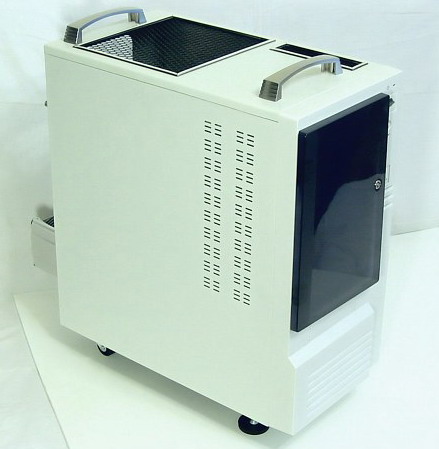I. Introduction.
The previous fanless construction has worked properly for near two years having undergone some insignificant redesign (mainly redecorating). In general it deserved only one censure – slow loading of levels in computer games because of laptop hard disks not united into raid. The time of upgrade came and we noticed at once the disadvantage of philosophy of components pacification with the help of remote radiators. Cooling system turned out to be strictly designed only for its hardware, and in our estimation it wasn’t easier to transfer it to another motherboard with another video adapter than to do everything from the ground up. Having thought a bit, we decided not to reinvent the wheel and retired the old computer in one piece.
I started making a new computer with corrections of mistakes to prevent headache at the time of future upgrades. Main result of this modding was unconditional refusal of remote radiators wherever possible, i.e. in the new variant each radiator should be placed directly on the cooled hardware. At the stage of designing this seemed to be more convenient solution – this guaranteed less bother with heat pipes; however in actual fact we didn’t eliminate the problem but only removed it. As known, ATX system is designed for horizontal blowing, and all the hardware components are mounted in the form of book-stand, one over another. It’s not difficult to guess that after the change of ventilation to convective – from the bottom upwards – they start to heat one another, at that the power supply unit not only takes upon itself the termal shock but prevents hot air from outlet. Fortunately, in my case I didn’t have to bother about hard disks, as they didn’t need any ventilation in view of the fact I used laptop. All other components gave some trouble. As a result the volume of work was the same as in the first project, and caused considerable cash expenses.
The first trouble we had to solve was as follows: a couple of aluminium plates of 30×30 cm can be perfectly placed on the outer walls of the case, but they don’t fit inside. Having looked through the last achievements of cooling systems manufacturers, I decided to think progressively and use composite radiators instead of cast. It is clear that I had to make them myself. This is the reason of a considerable part of cash expenses on the project, as you can find the component parts only having dismantled several heat-pipe coolers which, unfortunately, are not cheap. Second problem: radiators, as we’ve already mentioned, must be placed on the hardware directly, at the same time we had to scatter them in order they wouldn’t heat each other. I’ve got an idea how to solve this problem when I saw an unusual case in the market; the case had the size of a standard midi case but half as wide again. By the way, I haven’t seen such cases anywhere since then, and if I didn’t notice it who knows how my computer would look now. But I got what I needed. You can see the resulting lay-out in the photographs: I managed to put the radiators side by side but at different levels instead of the original “book-stand”. And the work began.

II. Components and modification.
After a thorough selection of components and taking into consideration heat generation and convenience of modding we’ve got the following configuration:
- Athlon 64 3200+ Orleans
- Gigabyte GA-M55Plus-S3G
- Corsair XMS2x512 5400C4PRO
- Leadtek PX7900GT THD Extreme
- FSP Epsilon FX600-GLN
It should be mentioned that I would prefer to take Zen instead of Epsilon, but there was no possibility to buy it in the described time. Overpay for the full-featured Corsair memory was vain, it didn’t show any outstanding features except the light-emitting diode bar, at least in conjunction with this mother board.
Proseccor
This was the easiest part for what many thanks to Scythe Co. – Ninja coped with the heat load of Athlon without any adjustment. I had to readjust the fasteners only, because I took one of the oldest mother boards for AM2 and Ninja rev.B was presented several months later. However, rev.A adaptation didn’t take me more then 15 minutes. I’ll describe the technique later. The finally achieved processor overlocking was 2600 MHz, at that this limit was caused not by the temperature but its own technological boundary value. At this frequency, and room temperature around 28 degrees, the stone under S&M was heated up to 75°C. Without any problems with stability.
Motherboard
I treated the mother board traditionally: I pasted radiators to transistors of the processor feeding system. I also pasted radiators on the other microchips, just in case.


